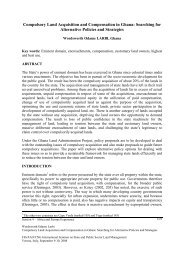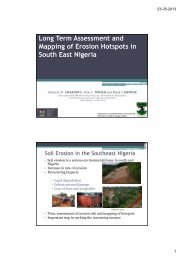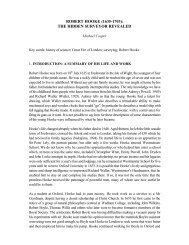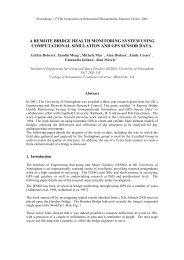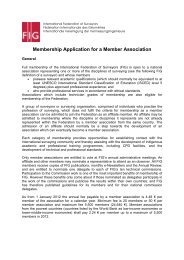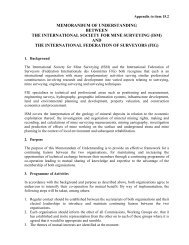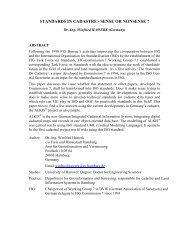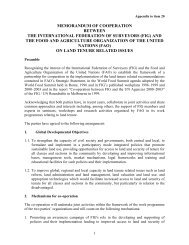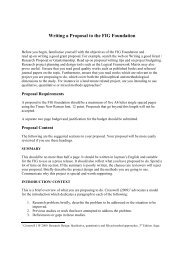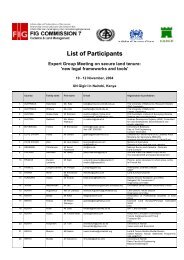Disposal of Land in New Zealand Presentation - FIG
Disposal of Land in New Zealand Presentation - FIG
Disposal of Land in New Zealand Presentation - FIG
Create successful ePaper yourself
Turn your PDF publications into a flip-book with our unique Google optimized e-Paper software.
Sale <strong>of</strong> State <strong>Land</strong> <strong>in</strong> <strong>New</strong> <strong>Zealand</strong><br />
Learn<strong>in</strong>gs from the <strong>New</strong> <strong>Zealand</strong> experience<br />
Craig Harris | Deputy Commissioner <strong>of</strong> Crown <strong>Land</strong>s and Manager Crown<br />
Property Regulatory, Crown Property and Investment<br />
Sem<strong>in</strong>ar <strong>of</strong> State <strong>Land</strong> Management, Budapest, September 2012
Introduction<br />
• <strong>New</strong> <strong>Zealand</strong> Context<br />
• Reforms <strong>of</strong> 1980s<br />
• <strong>New</strong> <strong>Zealand</strong> Sale Framework<br />
• Lessons<br />
• Conclusion
Image slide<br />
Firstly, a bit <strong>of</strong> context…<br />
The state <strong>in</strong> <strong>New</strong> <strong>Zealand</strong> owns about 45% <strong>of</strong> <strong>New</strong><br />
<strong>Zealand</strong>’s land area (about 15 million hectares)<br />
<strong>Land</strong> Information <strong>New</strong> <strong>Zealand</strong> manages over 3<br />
million hectares <strong>of</strong> state land<br />
That’s roughly 8% <strong>of</strong> NZ’s total land area,<br />
<strong>in</strong>clud<strong>in</strong>g over 5,500 properties, and 1.5<br />
million hectares <strong>of</strong> pastoral leases <strong>in</strong> the<br />
South Island high country.
State Sector Reforms<br />
• Between 1986 and 1996, the state underwent<br />
significant changes, <strong>in</strong>clud<strong>in</strong>g:<br />
– Move to a deregulated, market economy<br />
– Redef<strong>in</strong>ition <strong>of</strong> the state sector<br />
– Reform <strong>of</strong> the f<strong>in</strong>ancial management <strong>of</strong> government<br />
– Introduction <strong>of</strong> performance management and<br />
accountability systems across government<br />
– Split up <strong>of</strong> state agencies<br />
• These had significant impacts on how agencies<br />
managed state land
Impact <strong>of</strong> State <strong>Land</strong><br />
• These impacts <strong>in</strong>cluded:<br />
– state land with commercial uses was transferred to state owned<br />
enterprises<br />
– new specialist agencies created to manage land<br />
– emphasis to sell unneeded state land<br />
– treatment <strong>of</strong> state land as f<strong>in</strong>ancial assets<br />
– focus on commercial processes<br />
– reduction <strong>in</strong> public sector workforce deal<strong>in</strong>g with land, and<br />
– greater use <strong>of</strong> outsourc<strong>in</strong>g<br />
• S<strong>in</strong>ce 1990, LINZ has:<br />
– sold land worth approximately NZ$500 million (€320m)<br />
– enabled government agencies to sell land worth over NZ$1.5 billion<br />
(€1 billion)<br />
– developed sale frameworks, performance targets and strategic goals<br />
for state land
LINZ’s goal for state land<br />
“Enable appropriate economic, environmental, and<br />
recreational use <strong>of</strong> Crown-owned and –used land.”<br />
LINZ Statement <strong>of</strong> Intent
Reasons for sell<strong>in</strong>g State <strong>Land</strong><br />
• Sale <strong>of</strong> state land can occur to:<br />
– Ga<strong>in</strong> revenue<br />
– Reduce costs<br />
– Consolidate land hold<strong>in</strong>gs<br />
– Enable the land to be used for other purposes<br />
– Free land for economic development
State land enables other uses…<br />
Well<strong>in</strong>gton Stadium built <strong>in</strong> 2000 on<br />
railway land
…and economic opportunities
State land v Private land<br />
• Important to note that state land is not usually the same as<br />
private property. This is due to:<br />
– High <strong>in</strong>terest from citizens and media about state land<br />
– Desire to protect non-economic values, such as wildlife or<br />
social values<br />
– Specific legal requirements that apply only to state land<br />
– State sale processes likely to be different to purely<br />
commercial entities<br />
– Scrut<strong>in</strong>y from citizens on decisions made
Lessons<br />
1. Sale decisions should be made with<strong>in</strong> a<br />
clearly def<strong>in</strong>ed framework <strong>of</strong>:<br />
• Legal requirements<br />
• F<strong>in</strong>ancial report<strong>in</strong>g systems (e.g. accural account<strong>in</strong>g)<br />
• Strategy/policies for state land hold<strong>in</strong>gs<br />
• Clear accountabilities<br />
• Clear performance targets and goals<br />
• Documented decision-mak<strong>in</strong>g processes<br />
• Long-term sale programme<br />
• Strategies to deal with media and public enquiries<br />
• Audit and review processes
Lessons<br />
2. Retention <strong>of</strong> state land expertise is crucial<br />
to long-term success<br />
• In <strong>New</strong> <strong>Zealand</strong>, there is no educational qualification <strong>in</strong><br />
state land<br />
• Transfer <strong>of</strong> knowledge and expertise to private sector<br />
=> potential for over-reliance on private sectors<br />
• S<strong>in</strong>ce 2010, LINZ has:<br />
• <strong>in</strong>tegrated standard processes <strong>in</strong> new electronic land<br />
register<br />
• created <strong>in</strong>ternal and external tra<strong>in</strong><strong>in</strong>g programmes<br />
• developed knowledge management <strong>in</strong>itiatives (such as<br />
<strong>in</strong>ternal ‘Wikipedia’) to reta<strong>in</strong> knowledge
Lessons<br />
3. Gett<strong>in</strong>g good <strong>in</strong>formation on state land is<br />
vital before mak<strong>in</strong>g sale decisions<br />
• Accessible state records<br />
• Good electronic record systems<br />
• Use <strong>of</strong> GIS<br />
• Properties are assessed for<br />
• Physical characteristics (natural values, historic sites)<br />
• Historic actions and obligations<br />
• Current or potential risks<br />
• Appropriate uses
Lessons<br />
4. The private sector should take risk <strong>of</strong><br />
development<br />
• State land can be a valuable tool for economic<br />
development, but<br />
• Spend<strong>in</strong>g money to develop land (build<strong>in</strong>gs etc) for<br />
commercial use exposes state to significant risk and<br />
long-term expenditure<br />
• Ongo<strong>in</strong>g state <strong>in</strong>terests can be met by:<br />
• Allow<strong>in</strong>g a lease or licence rather than sale<br />
• Plac<strong>in</strong>g conditions on purchasers<br />
• Public-Private partnerships
Lessons<br />
5. Private sector can assist with sales<br />
• Private sector may have skills that state does not (e.g.<br />
market<strong>in</strong>g, commercial contract<strong>in</strong>g processes)<br />
• However, private sector <strong>in</strong>volvement should be<br />
managed by hav<strong>in</strong>g:<br />
• open, transparent and competitive tender<strong>in</strong>g processes<br />
• contract specifications and performance measures<br />
• actions to recognise specific issues with state land<br />
• mechanisms to ensure state agency reta<strong>in</strong>s all <strong>in</strong>formation<br />
on the land<br />
• report<strong>in</strong>g requirements<br />
• responsibility for mak<strong>in</strong>g high-risk decisions with state<br />
agency
Lessons<br />
6. Use competitive market processes if<br />
possible<br />
• All sales should be <strong>in</strong>formed by <strong>in</strong>dependent market<br />
valuation advice<br />
• Sale can be by:<br />
• Public applications or other <strong>in</strong>formal bidd<strong>in</strong>g processes<br />
• Formal tenders<br />
• Auctions<br />
• These encourage competition from prospective<br />
purchasers, are flexible and likely to achieve best price<br />
• Also provide transparency <strong>in</strong> how land was sold
Conclusion<br />
• State land is a f<strong>in</strong>ite, national resource with economic, social and<br />
environmental benefits and high <strong>in</strong>terest from citizens<br />
• This requires robust decisions on how to use that resource<br />
• Decisions should be transparent and consistent, not arbitrary<br />
• This requires good <strong>in</strong>formation on the land and support systems,<br />
such as f<strong>in</strong>ancial report<strong>in</strong>g<br />
• Private sector can help develop sold land and provide specialist<br />
services to state agencies<br />
• Market sale processes usually achieve the best price, and reduce<br />
potential for allegations <strong>of</strong> improper deal<strong>in</strong>gs <strong>in</strong> land
Thank you for your time.<br />
Any questions?



